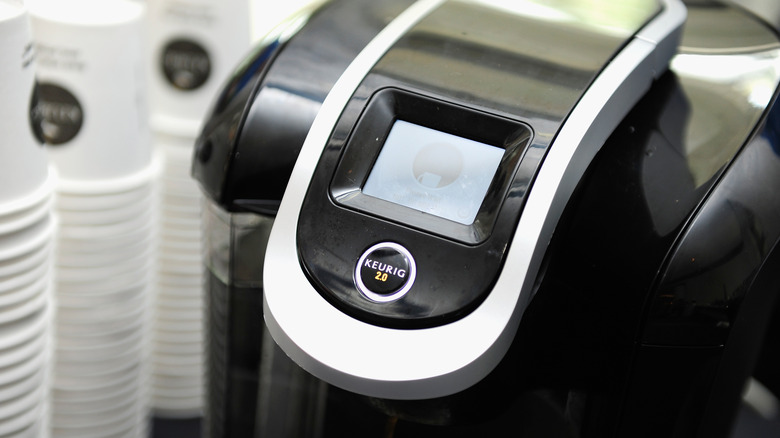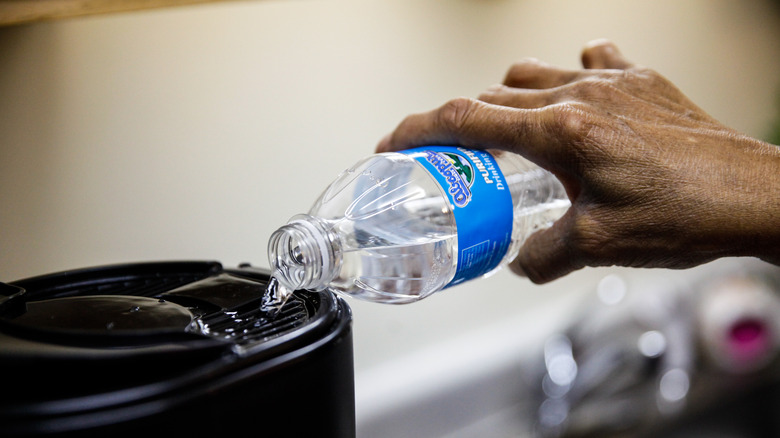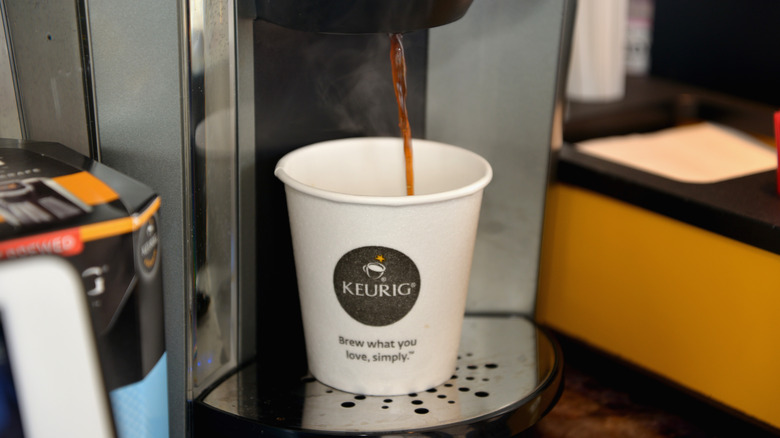What Everyone Gets Wrong When Cleaning Keurig Coffee Makers
A cup of coffee every morning is a necessity for many, but lousy upkeep of the machine used to brew it could impact the product's taste and quality. The coffee maker is one of the most frequently used appliances in the kitchen, so cleaning it regularly and using the proper items to do so are critical to ensuring the machine can operate consistently and efficiently. Pod coffee makers, like those manufactured by Keurig, are no different. A common mistake Keurig owners make when operating one of the brand's coffee makers is using distilled or alkaline water when cleaning the appliance or brewing coffee, an error that results in poor-tasting beverages and excessive limescale buildup that can end up breaking the machine.
There are many signs that signal when limescale buildup is negatively impacting your coffee maker's performance. You may notice that your coffee brews at a cooler temperature and at a slower pace than normal. This is due to the excessive clogging of key components inside the appliance like the heating element. Limescale also tends to alter the taste of your coffee, making it bitter and unsavory. And if left unaddressed for long enough, the residue can cause the metallic instruments inside your coffee maker to corrode, which may lead to expensive repairs and irreversible damage if you continue using it. Learn more about the best types of water to use to make your coffee maker last and how to meticulously clean the appliance in order to rid it of harmful contaminants.
Use the right type of water
A cup of brewed coffee is roughly 98% water, so the type of water you choose to add to your coffee maker's reservoir should be some of the cleanest and best quality possible. You wouldn't purposefully use contaminated water to drink or cook with, so the water that you use to make coffee shouldn't be treated any differently. Keurig recommends avoiding distilled and high-alkalinity water when brewing beverages with its line of smart coffee makers. The latter tends to leave behind traces of mineral residue, mainly calcium, magnesium, and potassium, all of which are added to increase the water's overall pH balance. Contrarily, distilled water contains no minerals or ions of its own. This may cause the brewed coffee to taste flat and create problems with the added coffee grounds and the appliance's inner parts. However, both distilled and alkaline water aren't as bad as water straight from the tap, which usually contains chlorine on top of the other minerals mentioned. Ideally, opt for filtered or bottled water instead.
The same principle applies when cleaning the coffee maker. Using water that's loaded with minerals like calcium and magnesium to clean the Keurig only accelerates the buildup of residue and limescale, which can cost a lot of money to fix or, in the worst cases, require the machine to be replaced entirely. Filtered spring water is also an effective substitution, so long as it doesn't have excessive amounts of added minerals.
How to descale your Keurig coffee maker
On top of washing the external components of your coffee maker by hand after each use, Keurig owners should descale their appliances to clean the machine's internal mechanisms and ensure the coffee tastes its best. Descaling is simply giving your Keurig a thorough clean, aiming to remove all limescale buildup that typically accumulates within the machine over time. These chalky, white deposits develop from using hard water to brew your coffee or water that contains a high concentration of minerals. While using water with a lower mineral content can help slow the accumulation of limescale, this residue will build up regardless. So, it's necessary to flush out any remnants to keep the machine in pristine working condition.
To descale your Keurig, hold off on descaling your coffee maker with vinegar and grab a bottle of Keurig's descaling solution instead. Pour the full bottle of descaling solution into your Keurig's emptied water reservoir, then fill the container with water and pour that in as well. With the machine off but plugged in, press and hold the 8- and 12-ounce buttons together for three seconds to activate the descale mode. Set a mug on the machine's drip tray to catch the filtered solution as it comes out. Repeat this process until the "Add Water" light starts blinking, and follow up with a series of clean water rinses. Descale your Keurig coffee maker once every three months or more frequently if you use it every day.


